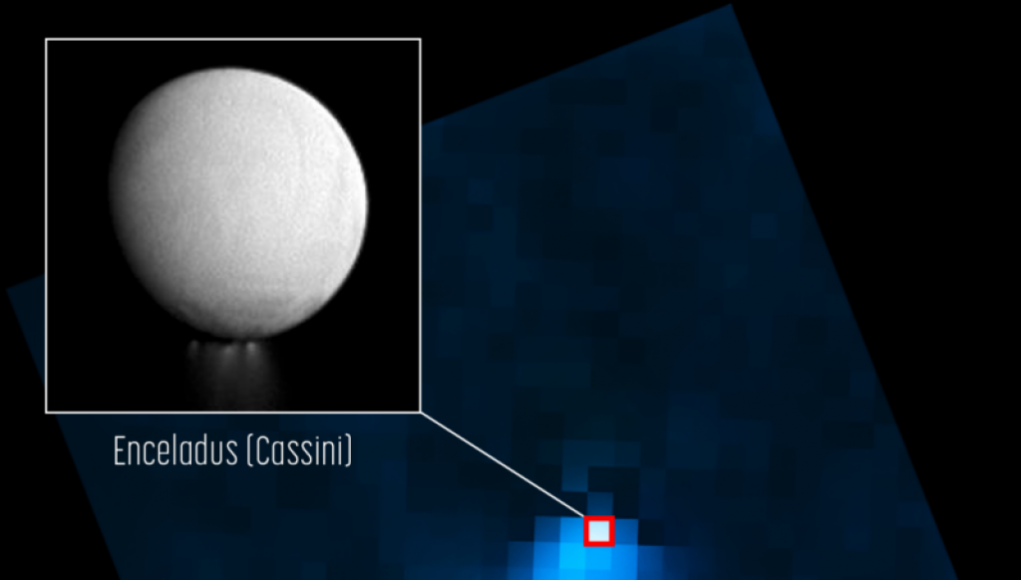The frozen moon Enceladus, which orbits Saturn, has always been a source of fascination for scientists due to the plumes of water vapor that erupt from its icy crust. These plumes are believed to be evidence of a subsurface ocean, which means that there is a possibility of life on the moon. Recently, NASA’s James Webb Space Telescope (JWST) captured an image of a plume that is unlike any other.
The plumes of water vapor on Enceladus are formed via cryovolcanoes that emerge from cracks in the ice. These plumes can extend for hundreds of miles from the surface. Upon analyzing the new JWST data, a team of NASA researchers discovered that one plume near the moon’s south pole was far larger than any other. This plume is over 9,500 km (6,000 miles) long, making it the most extensive spray of water ever seen in space. It is 20 times the size of Enceladus itself and extends far enough to easily cover the distance from Los Angeles to Buenos Aires. As Enceladus continued to orbit Saturn, this water vapor plume formed a ghostly halo around the planet.
“This level of [water] activity… establishes Enceladus as a prime source of water across the Saturnian system,” the researchers said in a study accepted for publication in Nature Astronomy.
The halo that Enceladus leaves in its wake actually creates most of Saturn’s E-ring, which is its largest outermost ring. Though Enceladus was suspected to be geologically active since the Voyagers visited Saturn, NASA researchers analyzing data from the Cassini orbiter and Herschel Observatory first confirmed the existence of geysers in 2005. In 2019, further Cassini observations showed the E-Ring was largely formed by water vapor plumes gushing out of Enceladus, which explains why this ring appears fainter and hazier than the others.
Webb’s instruments were able to tell that most of the droplets of water from the vapor Enceladus regularly spews out don’t stay within the torus near the moon. Its 33-hour orbit—just 1.37 days on Earth—means that it sprays water vapor widely around Saturn. It does so especially fast, with the megaplume spraying an astounding 300 liters (79 gallons) every second. The observations Webb beamed back indicate that only about 30 percent of that water stays in the torus, while 70 percent is dispersed throughout the rest of the Saturnian system. Meaning, Enceladus supplies the system with most of its water.
Webb’s observations were done using the Integral Field Unit (IFU), which can simultaneously image an object and see the spectra it is giving off, which tells us what substances make up the object. The IFU is part of Webb’s Near-Infrared Spectrograph (NIRSpec) instrument, which can see molecular emissions across a broad range of the infrared spectrum. Infrared emissions coming from the plume revealed not only that it was made up of water vapor, but how far that water vapor extended from the surface, which revealed its immense size.
The NIRSpec data was also checked for organic molecules such as carbon monoxide, carbon dioxide, methane, ethane, and methanol, which could be possible indicators of life or prebiotic processes. There were no traces of these organics in the plume.
“Even though there were no organics in the megaplume, the vaporous plumes of Enceladus are thought to originate from hydrothermal vents deep in its subsurface ocean. These formations are also found on Earth’s seafloor, where hot water heated by underground magma gushes into its otherwise freezing surroundings. The core of Enceladus generates enough heat to keep water liquid,” the researchers said in the study.
Maybe someday, another cryovolcanic eruption captured by Webb could show evidence of life in the hidden world of its ocean. Enceladus water vapor has already been found to contain organic compounds that are capable of chemically reacting to produce amino acids, the building blocks of life on Earth, and someday, we may see more potential signs of life emerge.
On January 13th, 2021 the Stratospheric Observatory for Infrared Astronomy (SOFIA), a large aircraft carrying a 2.7 meter telescope, recorded a massive water vapor plume on Enceladus, a moon of Saturn. This plume acts as an outlet for gushing icy particles ejected from the moon’s south polar region.
Using the observatory’s telescope, researchers recorded water vapor in the plume that was ten times more abundant than anticipated. In the fine details of the image captured, teams of researchers saw temporal variability and concentration changes at different locations within the plume. The image also revealed that the shape of the plume is highly circular and extends through the moon’s northern hemisphere. This discovery opens up a significant amount of knowledge for researchers and scientists alike to discover more about the water cycles of Enceladus which is crucial to understanding the icy moon’s potential for life sustaining processes.
The detection of this massive plume comes from technology onboard the SOFIA aircraft that uses infrared radiance. This same infrared radiation technology was used by James Webb Telescope. With the next generation of observation technology, scientists and researchers are able to record infrared radiation from the surface of the moon, which could provide further understandings and mysterious surrounding Enceladus.
The presence of water vapor, as well as intricate geological features on Enceladus indicate that geothermal thermodynamic processes are actively taking place, potential hints of the development of a habitable zone. With this new finding from the Webb Telescope, more research could be conducted to determine the potential of life on other planets in the solar system.
Overall, the Webb Telescope discovering the massive water vapor plume on Enceladus is an monumental finding for the research and science community as it marks a milestone in understanding our universe and potentially discovering life-sustaining regions beyond the Earth.




















